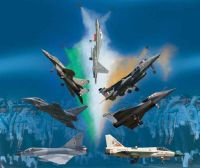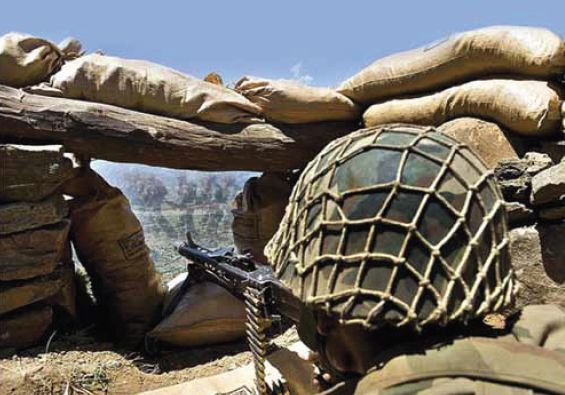This article is published with the kind permission of “Defence and Security Alert (DSA) Magazine” New Delhi-India
An excellent overview of the evolution of aerospace power in India and the way ahead. The writer highlights the fact that the combat potential of the combat fleet of the IAF has been declining over the last decade is not a closely guarded secret. With the MiG-23 fleet and several squadrons of MiG-21 procured in the sixties / seventies phased out and the LCA Tejas not yet operational, there has been considerable erosion of combat potential. Even with the induction of seven squadrons of the Su-30MKI so far, the strength of fighter squadrons in the IAF stands at 33.5 against the authorised 39.5. As per the Ministry of Defence (MoD), the remaining nine squadrons of the accident-prone MiG-21 fleet would be phased out by 2017. By then, the IAF hopes to receive another eight squadrons of the Su-30MKI. If no other combat aircraft is inducted, by the end of 2017, the IAF will have a fleet of only 32.5 combat squadrons. He concludes grimly that the effort at the contemplated transformation of the IAF into a modern aerospace power in a practical time frame, will face challenges from the controlling politico-bureaucratic systems that are perhaps as daunting as those from the enemy.
 |
Established on October 8, 1932, the Indian Air Force (IAF) has now entered its eightieth year of existence. During its glorious history, the combat elements of the IAF underwent baptism by fire in the 1930s operating against rebel forces on the North West Frontier and later in Burma during World War II. Their mettle was again tested against fierce opposition by Pakistan Air Force in the wars in the sub-continent in 1965 and 1971. The combat fleet went into action once again in Kargil in 1999 albeit without aerial opposition. Each time the spearhead of the nation’s air power exerted a decisive influence on the outcome of the conflict.
Since independence, the transport and helicopter fleets of the IAF have been rendering yeomen service supporting the forward deployment of the ground forces along the inhospitable northern and north-eastern frontiers. However, on four occasions, the transport fleet of the IAF has been employed aggressively, each time playing a crucial role in furthering national security interests. The first was the daring mission on October 27, 1947 to land three Dakota aircraft at Srinagar airfield with troops to prevent it from falling into the hands of the Pakistan-sponsored invaders. With Srinagar airfield secured, reinforcements were inducted speedily by air and the Valley was thus saved. On December 11, 1971, 36 transport aircraft of the IAF carried out an airborne assault operation behind enemy lines in the then East Pakistan. The 700 paratroopers dropped behind enemy lines at Tangail, cut off retreat of the Pakistani forces hastening collapse of Dacca, bringing to an end the war in the east.
In the last week of July 1987 the IAF airlifted a 10,000-strong military contingent from Hyderabad to Jaffna as the lead element of the 80,000-strong Indian Peace Keeping Force (IPKF) in accordance with the historic Indo-Sri Lanka Accord. The IAF transport fleet remained the lifeline for the IPKF throughout their deployment in Sri Lanka. IAF helicopters were used extensively for logistic support, reconnaissance, communication duties and offensive missions. But the most dramatic military intervention at long range by the IAF was in the Maldives on the night of November 3, 1988. The operation was undertaken in response to a request from the government of the Maldives for urgent military assistance to counter externally sponsored invasion. Two IL-76 aircraft with 400 Para Commandos flew directly from their base in Agra to Hulule airport in the Maldives 2,000 km from the Indian peninsula. The swift military intervention in a distant land was possible only through long range strategic airlift aircraft.
Challenges ahead
The nation can derive satisfaction from the fact that the IAF lived up to expectations each time it was called into action. However, the IAF must now prepare for the challenges looming over the horizon. Speaking on the occasion of the IAF anniversary in October 2010, Air Chief Marshal P V Naik, the then Chief of the Air Staff described the prevailing security scenario in India’s neighbourhood as “a volcano that may erupt anytime”. He went on to say that “operational preparedness was the key to meet the complex threat with swift response, flexibility and precision”. As per the Air Chief, the IAF was in the process of transformation into a potent aerospace power by 2017. The statement of the CAS succinctly drew attention to the challenges that lay ahead for the IAF. The traditional foe Pakistan although on the verge of being a “failed State”, ought not to be underestimated as it continues to receive potent combat aircraft from the US and in larger numbers from China. The Peoples Liberation Army Air Force (PLAAF) on the other hand is rapidly evolving from an antiquated force to a modern aerospace power. Its combat fleet has the cloned versions of the latest Russian fighters and has even test flown its indigenous fifth generation fighter. In terms of numbers, the PLAAF is three times the size of the IAF. India cannot afford to ignore China’s rise as a military and economic giant on the global arena.
India is also emerging as a regional economic and military power and its security interests now transcend its borders extending from the Middle East to South East Asia. As a regional power, India will be expected to play a critical role towards regional security and stability. Such a responsibility will require the nation to possess the capability of power projection. India therefore needs not only a potent combat force but also the means to transport swiftly and deploy combat power over long distances within and beyond national boundaries. India’s capability to play a meaningful role as a regional power, will therefore hinge to a large extent on a powerful and balanced Air Force.
The traditional foe Pakistan although on the verge of being a “failed State”, ought not to be underestimated as it continues to receive potent combat aircraft from the US and in larger numbers from China. The Peoples Liberation Army Air Force (PLAAF) on the other hand is rapidly evolving from an antiquated force to a modern aerospace power. Its combat fleet has the cloned versions of the latest Russian fighters and has even test flown its indigenous fifth generation fighter. In terms of numbers, the PLAAF is three times the size of the IAF
However, what needs to be evaluated is the state of operational preparedness of the IAF today and as to whether the “process of transformation into a potent aerospace power” as purported by the CAS, is actually on schedule.
Combat potential
The fact that combat potential of the combat fleet of the IAF has been declining over the last decade is not a closely guarded secret. With the MiG-23 fleet and several squadrons of MiG-21 procured in the sixties / seventies phased out and the LCA Tejas not yet operational, there has been considerable erosion of combat potential. Even with the induction of seven squadrons of the Su-30MKI so far, the strength of fighter squadrons in the IAF stands at 33.5 against the authorised 39.5. As per the Ministry of Defence (MoD), the remaining nine squadrons of the accident-prone MiG-21 fleet would be phased out by 2017. By then, the IAF hopes to receive another eight squadrons of the Su-30MKI. If no other combat aircraft is inducted, by the end of 2017, the IAF will have a fleet of only 32.5 combat squadrons. The IAF is banking on the induction of six squadrons of the Medium Multi-Role Combat Aircraft with which the tally will go up to 38.5 squadrons, still short of the currently authorised level. Besides, the MoD intends to enhance the number of combat squadrons to 42 by the end of the decade, a figure close to an earlier assessment of 45 squadrons to fight a full-scale war on one front and holding action on the other. However, in case the nation is embroiled in a full-scale two-front war against China and Pakistan simultaneously, it will need a 60-squadron Air Force.
However, the immediate shortfall of 3.5 squadrons can be made up with the LCA Tejas provided it receives Final Operational Clearance and the IAF doubles the order for 40 aircraft already placed. Alternatively, there is talk of enhancing the order for MMRCA by 63 aircraft (three squadrons). Besides, HAL has entered into a joint venture with United Aircraft Corporation of Russia to produce a customised twin-seat version of the Russian T‑50 PAK FA. Referred to as the Fifth Generation Fighter Aircraft (FGFA), the IAF is expected to get around 250 (14 squadrons) with induction beginning in 2017. This fleet will in due course replace the 17.5 squadrons of third generation aircraft that have been in service with the IAF for over 25 years. These include the MiG-27, MiG-29, Jaguar and the Mirage 2000. With midlife upgrade at phenomenal cost underway, these aircraft may continue in service up to 2025. Beyond this date, the combat fleet of the IAF will comprise the upgraded Su-30MKI, the MMRCA, the FGFA and the Tejas MkII.

 von
von 


